Applause for Choir and Orchestra Long and Loud on European Tour
Contributed By R. Scott Lloyd, Church News staff writer

The Mormon Tabernacle Choir and Orchestra at Temple Square perform at the Musikverein in Vienna—former home venue of Johannes Brahms, Gustav Mahler, and other legends of classical music—during a sold-out concert on July 2 as part of their 20-day tour of western Europe.
VIENNA, AUSTRIA
A sold-out concert July 2 at the prestigious Musikverein in Vienna—former home venue of Johannes Brahms, Gustav Mahler, and other legends of classical music—capped the first week of a 20-day tour of western Europe by the Mormon Tabernacle Choir and Orchestra at Temple Square.
The concert was preceded by two performances in Germany: Berlin on June 29 and Nuremberg on July 1. All three have been well received, with enthusiastic standing ovations and double encores at each event.
The event in Vienna was unusual in that it was presented on Sunday, but also in the fact that the proceeds from the ticket sales were entirely donated to charity, in keeping with Christ’s teaching that it is “lawful … to do good” on the Sabbath day (see Luke 6:9).
Choir announcer Lloyd Newell announced the donation just after the first encore selection, “Battle Hymn of the Republic.”
“All of the proceeds from this evening’s concert, along with a generous donation from The Church of Jesus Christ of Latter-day Saints humanitarian fund, are being donated to Caritas Austria,” Brother Newell said. “This is for Caritas projects for local citizens as well as for refugee projects.”
He added that the charity’s “broad scope of programs underscores its enduring commitment to prevent and ease the hardship of the poor and less fortunate. Tonight’s donation is an example of how musicians and patrons of the arts can join together in worthy causes to help those in need,” a comment that brought appreciative applause from the audience.
Earlier in the program, Brother Newell said the choir had performed “one previous time in Vienna, and that was in 1991, in this very hall.” He asked if any had attended that concert; many raised their hands, including Tabernacle organist Richard Elliott, who performed with the choir on that occasion.
Home to the Vienna Philharmonic Orchestra (which maintains a six-year waiting list for tickets) the Musikverein is one of the finest concert halls in the world, said choir member and Brigham Young University professor of music Luke Howard. Brahms was the principal conductor there from 1872 to 1875, and Mahler conducted the orchestra there from 1898 to 1901. Many major orchestral works premiered in the hall, including Tchaikovsky’s violin concerto.

The interior of the prestigious Musikverein in Vienna—former home venue of Johannes Brahms, Gustav Mahler, and other legends of classical music—where the Mormon Tabernacle Choir and Orchestra at Temple Square performed a sold-out concert on July 2. Photo by Debra Gehris, Mormon Tabernacle Choir.
Its unusual configuration had a portion of the choir seated on the balcony overlooking the stage and flanking the organist at the console, situated immediately beneath the distinctive pipes. Some of the singers in the balcony were unable to see the conductor and had to rely on their musical instincts and observation of other choir members to anticipate cut-offs or other direction.
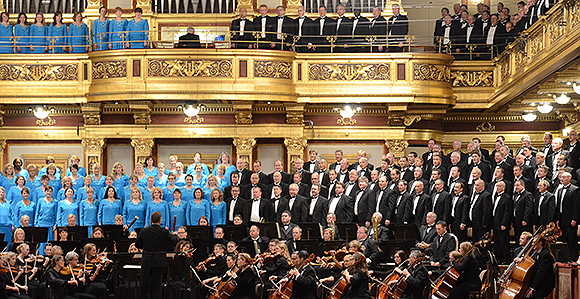
The Mormon Tabernacle Choir and Orchestra at Temple Square fill the stage and part of the balcony of the prestigious Musikverein in Vienna during a sold-out concert on July 2. Photo by Debra Gehris.
In his greeting to the audience, Brother Newell noted that the choir and orchestra members are all volunteers and that they trace their roots through Europe. To demonstrate, he asked all the performers to stand who had family connections or roots in Austria; about 20 did so. He then asked how many had roots or family connections in Europe; all of the performers stood.
Earlier in the day, the tour participants enjoyed lunch in the basement and dinner in the ballroom of the massive and ornate Vienna City Hall.

Members and guests of the Mormon Tabernacle Choir and Orchestra at Temple Square enjoy dinner in a ballroom of Vienna City Hall prior to performing that evening at the Musikverein on July 3, 2016. Photo by R. Scott Lloyd.
Some had been to Vienna before, as missionaries or in other capacities.
David Marsh, cellist with the orchestra for 15 years and with the now-defunct Mormon Youth Symphony for 25 years, was a missionary in Austria from 1971 to 1973. “I had great experiences, both in Vienna and also in Salzburg and some of the interior cities with very small branches,” he said. “As well as being a missionary, I wished I could have used my cello to do missionary work. Finally I get the opportunity I’ve been dreaming about for years to be able to return to my wonderful Austria and be able to bring the Spirit of God through music.”

David Marsh, shown with his wife, Tawna, plays cello with the Orchestra at Temple Square and served his mission in Austria. A performance on July 3, 2016, with the Mormon Tabernacle Choir now gives him the chance to use his musical talent to share the gospel. Photo by R. Scott Lloyd.
By prior arrangement, a man he baptized as a missionary, Peter Cunia, a former guide, took Brother Marsh’s wife, Tawna, and a small group of Tabernacle Choir tour guests on a sightseeing excursion around the central part of Vienna.
In Nuremberg, the choir and orchestra performed at Meistersingerhalle, the principal concert and convention hall in the centuries-old city.
Completed in 1963, the facility is named after the medieval tradition of the Meistersinger, especially as depicted in Richard Wagner’s opera Die Meistersinger von Nürnberg, Brother Howard said.
The 2,100-seat hall is the home of the Nuremberg Symphony and Nuremberg Philharmonic orchestras.

Musical director Mack Wilberg leads the Mormon Tabernacle Choir and Orchestra at Temple Square in a performance July 1, 2016, at Meistersingerhalle in Nuremberg. Photo by R. Scott Lloyd.
Nuremberg has a prominent Mormon Tabernacle Choir connection in that longtime Salt Lake Tabernacle organist Alexander Schreiner was born there on July 31, 1901. His parents, Johann Christian Schreiner and Margarethe Schwemmer, joined the Church there in 1903, and Church meetings were held in their home. Young Alexander was exposed early to his eventual career path, as he was called to be a Sunday School organist at age eight. The family immigrated to Salt Lake City in 1912.
Brother Schreiner’s daughter, Julianne Schreiner Johnson, is a former Tabernacle Choir member and, as a former violinist for the Utah Symphony, has performed in Nuremberg’s Meistersingerhalle.
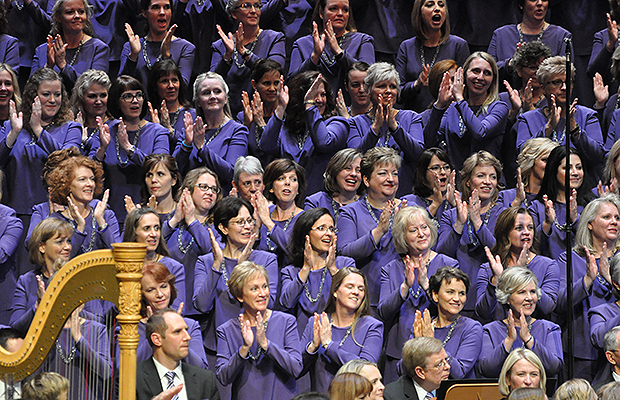
Members of the Mormon Tabernacle Choir clap rhythmically during a performance of the Nigerian Christmas carol “Betelehemu” at a concert at Nuremberg's Meistersingerhalle on July 1. Photo by Debra Gehris.
Known by many as the location of the international tribunal that tried Nazi war criminals after World War II, Nuremberg has a much richer history than that, extending back many centuries.
While the choir and orchestra was busy with a pre-concert sound check and rehearsal, guests toured the Imperial Palace, a proper medieval castle with four towers and a former moat. A vestige of the Holy Roman Empire, the castle dates back to 1050 with additions in later centuries.
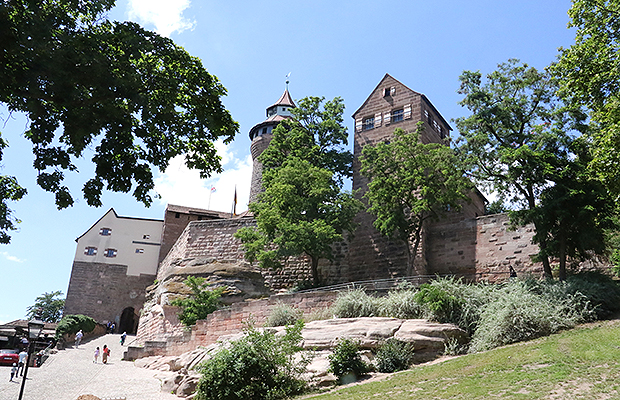
Spouses and guests of choir and orchestra members toured the Nuremberg Imperial Castle while members of the Mormon Tabernacle Choir and Orchestra at Temple Square were busy with sound check rehearsal prior to the concert. Photo by R. Scott Lloyd.
In Berlin, the choir and orchestra played to a sold-out audience of 2,100 at the Berlin Philharmonie. Completed in 1963, it became the model for concert halls worldwide, including the concert hall in the Sydney Opera House in Australia and the Walt Disney Concert Hall in Los Angeles, California, Brother Howard said.
It was at the choir and orchestra’s Berlin concert that what many see as a defining moment for the concert tour occurred.
It happened during the second half.
The final note of “Battle of Jericho” had scarcely been sounded when an enthusiastic audience member yelled out, “Whoa!”
“It wasn’t just that he said it, it was the way he drug it out and the scoop that he put into the tone of voice,” said bass singer Bob Walker. “It was exuberant! I felt an electrical energy go through the people around me when he said that, because it was the kind of real-time feedback that told us we were on track.”
Some here are seeing a deeper meaning in it as they consider the line “and the walls came tumbling down” and apply it to the removal of the Berlin Wall, that hated icon of the Cold War.
Earlier in the day choir and orchestra members and guests had viewed the remains of the wall. Much of it has been dismantled since 1989, when the breaching of the wall became a symbol of the dissolution of the Soviet Union and its attendant control over East Germany.

Iron poles marking the footprint of some of the dismantled Berlin Wall frame a group of participants of the Mormon Tabernacle Choir and Orchestra at Temple Square European tour July 29, 2016. Photo by R. Scott Lloyd.
“I’ve already felt the Spirit powerfully as I’ve walked the wall trail here in Berlin,” said choir member Joe Haynie in a letter he wrote to choir president Ronald Jarrett and shared with the Deseret News. “The feelings I’ve had about the fall of the Berlin Wall made me make connections to the walls of Jericho we’ll be singing about tonight. To me, the underlying message of the song is that through the Atonement [of Christ] we can be freed from the myriad inner constraints we face.” Choir member David Fischer’s parents, Hans and Helga, were residents of East Berlin in 1954 during the Cold War and escaped to the west.
“At that time you could cross back and forth, but if you wanted to leave East Berlin, you couldn’t take anything with you,” he said. “So they had to sneak all their clothes out in a baby buggy. They could kind of feel what was coming, so they decided to leave.”
This is the choir’s fourth visit to Germany; previous occasions were in 1955, when it performed in Berlin and Wiesbaden. The second was 1973, with performances in Munich and Oberammergau. The third was in 1991, with stops in Frankfurt, Dresden, and Berlin.
Sonja Sperling Poulter, alto in the choir, clearly remembers that latter occasion, as she was a child of seven growing up in Frankfurt.
“It was the coolest thing ever that the choir would come from America to sing for us, and now, to be part of them on the other side is just magnificent,” Sister Poulter reflected in an interview.
“I’m coming home,” she said. “I get the chance to show my American family where I’m from, why I am who I am, but I also get to show my family and friends here what I do and what I believe is true.”
She added, “This is a magnificent choir that brings a special, special spirit, and to be able to share that with my people here is wonderful.”

Choir member Sonja Sperling Poulter interprets for choir announcer Lloyd Newell during the choir and orchestra's concert in Nuremberg's Meistersingerhalle on July 1. Photo by Deb Gheris.
Sister Poulter has been visible this trip as interpreter for announcer Lloyd Newell’s comments to the audiences and for dignitaries at pre-concert receptions.
At each concert so far, the audience has given raucous standing ovations and demanded two encores.
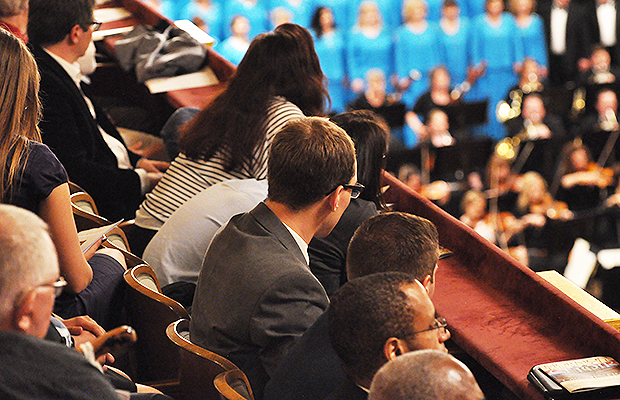
Audience members listen to the Mormon Tabernacle Choir and Orchestra at Temple Square perform during a concert in the Musikverein in Vienna—former home venue of Johannes Brahms, Gustav Mahler, and other legends of classical music—during a sold-out concert on July 2. Photo by Deb Gehris.
Brother Howard had warned the singers and instrumentalists prior to departure that Europeans are sophisticated in their tastes for art and music and that even though the choir is famous, members should not take for granted that they would receive the enthusiastic responses they are used to with the hometown crowds in Salt Lake City.
But the applause has been instant, long, and loud.

Audience members at Nuremberg's Meistersingerhalle on July 1, 2016, give a standing ovation for the concert by the Mormon Tabernacle Choir and Orchestra at Temple Square. Photo by R. Scott Lloyd.
“It has been such a pleasure for us to be with you this evening, and we have felt so welcomed by the good people of this beautiful and historic city,” Brother Newell said at the Berlin concert and repeated at Nuremberg and Vienna.
“We hope to see you again [more applause]. Until we do, ‘Gott sei mit euch,’” he said, invoking the title of the German translation of the choir’s familiar farewell hymn, “God Be with You Till We Meet Again,” which was then performed in German, to the obvious delight of the audiences.
Musical director Mack Wilberg and associate musical director Ryan Murphy share conducting duties for the program.
The first half is based on the hymn tune “Old Hundredth,” familiar to Latter-day Saints as the melody of “Praise God from Whom All Blessings Flow” and includes two songs of praise: “How Excellent Thy Name” by Georg Friedrich Handel and “Psalm 148” by Gustav Holst.
Also in the first half is the majestic Charles Gounod anthem so well received at last year’s U.S. East Coast tour, “Unfold, Ye Portals”; Gioacchino Rossini’s “Cum Sancto Spiritu”; Brother Wilberg’s own “Requieum aeternam”; William Albright’s “Agnus Dei”; Alberto Ginastera’s “Alleluia” from Psalm 148; and Johann Sebastian Bach’s “Herr, Gott, dich loben alle wir.”
The second half of the program begins with a set called “World Music of Rejoicing” and includes the Sephardic wedding song “A, el novio no quere dinero” and the perennial favorite “Betelehemu,” with its intricate African rhythms and with the choir delighting audiences by moving to the music.
Also included in the second half are pieces “from the American songbook,” including “Pilgrim Song,” “Come Thou Fount of Every Blessing,” “Battle of Jericho,” “Deep River,” and “Cindy.”'
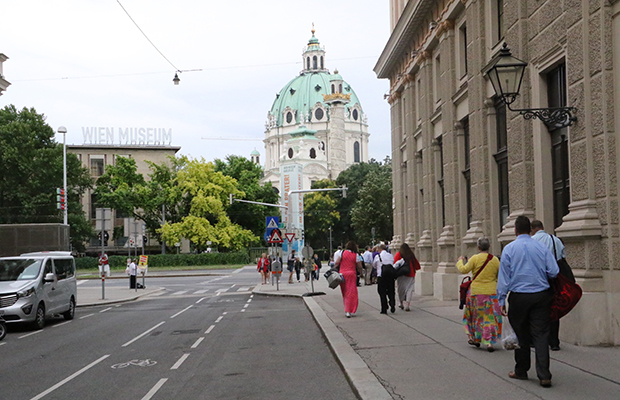
In Vienna, Austria, members of the Mormon Tabernacle Choir and Orchestra at Temple Square walk to the entrance of the Musikverin for sound check rehearsal on July 3, 2016. Photo by R. Scott Lloyd.
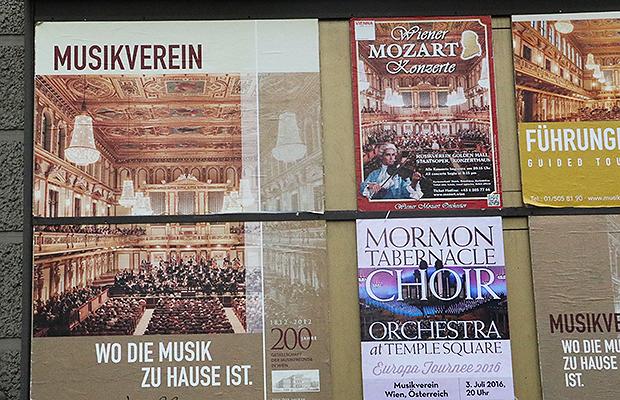
A notice on the exterior of the Musikverin at Vienna, Austria, tells of the concert that evening of the Mormon Tabernacle Choir and Orchestra at Temple Square on July 3, 2016. Photo by R. Scott Lloyd.

Performers view sign at the Musikverein in Vienna, Austria, where the Mormon Tabernacle Choir and Orchestra at Temple Square performed on July 3, 2016. Photo by R. Scott Lloyd.
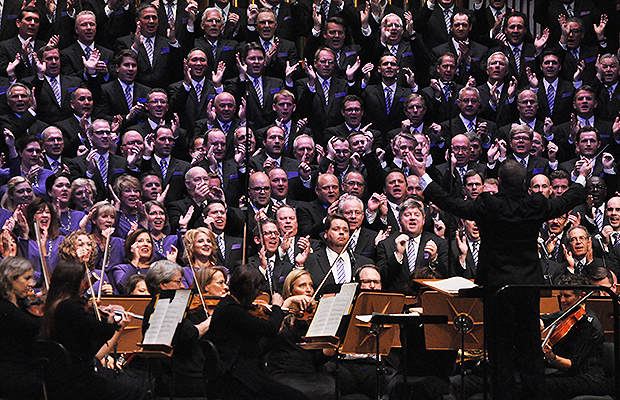
Associate director Ryan Murphy conducts the Mormon Tabernacle Choir and Orchestra at Temple Square during a concert July 1 at Meistersingerhalle, the principal concert and convention hall in the centuries-old city of Nuremberg in Germany. Photo by Deb Gehris.

Male section of the Mormon Tabernacle Choir is seen during a performance of the choir and Orchestra at Temple Square at Nuremberg's Meistersingerhalle on July 1, 2016. Photo by R. Scott Lloyd.
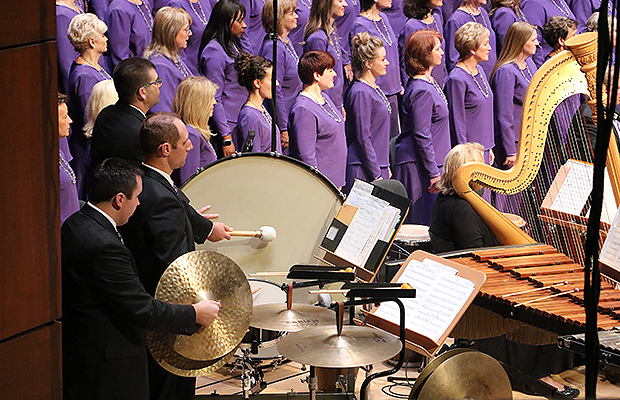
Percussionists perform during “Come, Come, Ye Saints” at Nuremberg's Meistersingerhalle on July 1, 2016. Photo by R. Scott Lloyd.
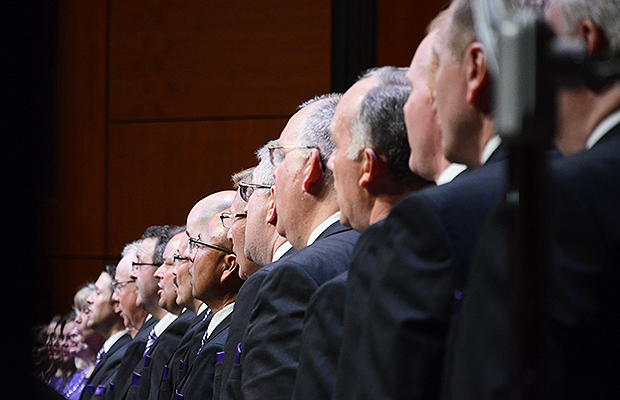
The Mormon Tabernacle Choir and Orchestra at Temple Square perform on July 1 at Meistersingerhalle, the principal concert and convention hall in the centuries-old city of Nuremberg in Germany, as part of their 20-day European tour. Photo by Debra Gehris.
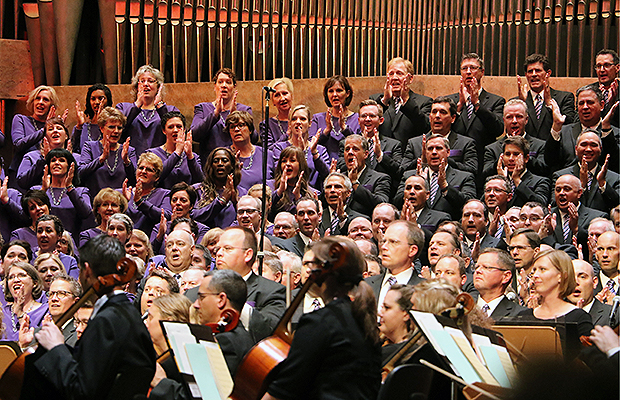
Mormon Tabernacle Choir members clap rhythmically during a performance of the Nigerian Christmas carol “Betelehemu” at a concert at Nuremberg's Meistersingerhalle on July 1, 2016. Photo by R. Scott Lloyd.
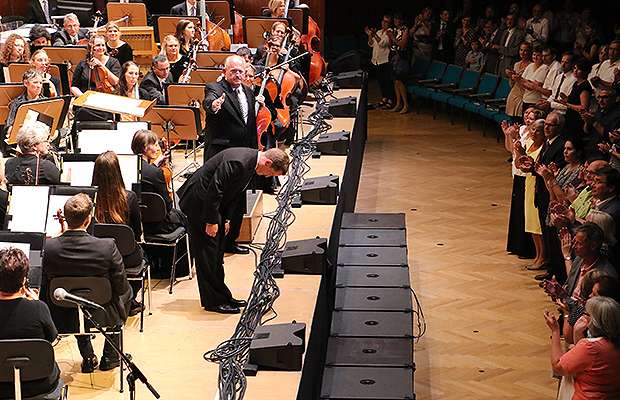
During a standing ovation, musical director Mack Wilberg acknowledges associate musical director Ryan Murphy at a performance in Nuremberg, Germany, of the Mormon Tabernacle Choir and Orchestra at Temple Square. Photo by R. Scott Lloyd.
